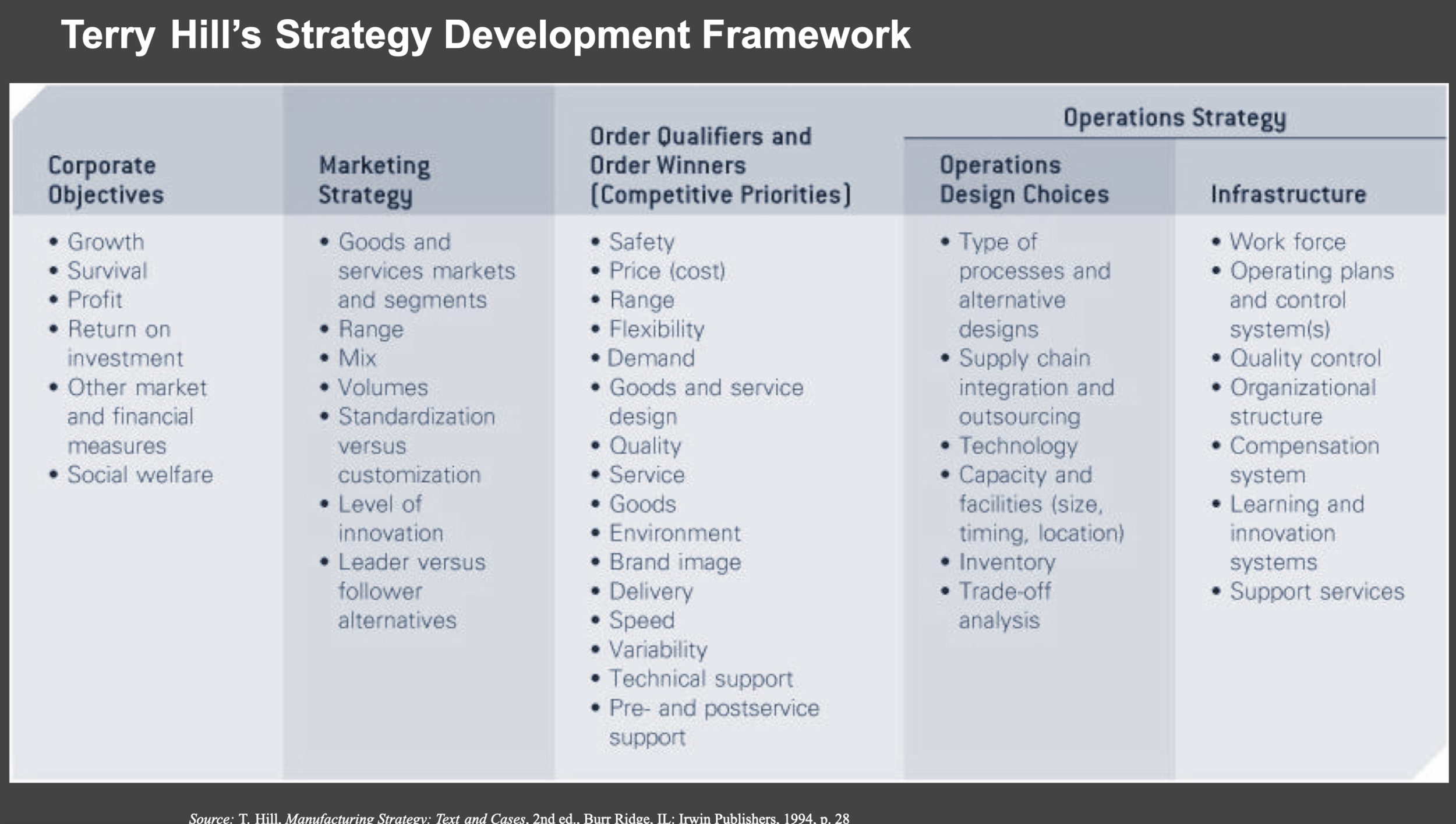Over the last few weeks, I’ve been working on a new project, helping our client communicate their operating model and engage different stakeholders across their organization.
Having a great strategy and operating model is not going to help the organisation if all the departments involved do not follow and stick to it. The more complex an organisation and the more diverse its products and markets, the more important aligning across functions to achieve one common goal (the budget) becomes.
I have found this topic to be very interesting, particularly because it shows the role of communication and collaboration and how important alignment across departments and functions is to achieve a common goal.
“It’s one thing to design a strategy in the boardroom and quite another to get it operating at all levels of the organisation.”
The strategy framework developed by Professor Terry Hill perfectly illustrates how businesses succeed when their major functions work together to formulate and execute a business strategy (see illustration below).
Strategy (how to reach the goal),
Execution (how to execute the strategy) and
Performance (is the strategy driving the expected results? If not, is it a matter of strategy or execution?)
are recurrent issues for smaller companies and big corporations operating in every sort of industry.
The goal of this business review is to share some recent articles as well as my thoughts on this topic.
How can strategic statements be translated into action?
According to Graham Kenny, the first step is to Narrow Your Focus. Each company should have a limited number of strategic focuses that reflect industry/company priorities. The company’s goals should be realistically achievable given its current resources and capabilities.
“Better to aim for a few important things for the year and celebrate success when they’re achieved.”
So the first step to successful execution is to identify and focus on strategic priorities. Don’t try to achieve too much as you might set yourself up for failure. The more you try to achieve, the less you’ll accomplish.
The second step is to translate every strategy into clear actions, starting with an imperative. Actions should be addressed to a specific person and should be completed by a predetermined date.
Ownership is key. The implementation of a strategy across an organisation implies that individuals in specific departments have specific targets measured through KPIs and are accountable to them. For each strategy statement, it is essential to identify what departments are involved, what their responsibilities are and how their results can be measured. In a complex organisation where more than one department is responsible for each strategy, ownership/leadership for the project needs to be clear.
Day-to-day (operational) problems are often competing against longer-term (strategic) problems, and the day-to-day tend to take precedence. One solution suggested in this article is to establish two meeting schedules for executing on a strategy: one for operational reviews and the other for strategic reviews, with operational meetings taking place once a week (or more frequently) and strategy review meetings occurring once a month.
Leaders should be responsible for monitoring progress, not only through KPIs but also by keeping team engagement high.
Is it clear to everyone what strategy means?
According to the article “Your Strategic Plans Probably Aren’t Strategic, or Even Plans” by Graham Kenny, the answer is no. Let’s see why.
Though executives talk “strategy,” they can hardly distinguish between “objective,” “strategy” and “action.” Understanding this is essential:
Objective: something you’re trying to achieve — a marker of the success of the organization.
Action: occurs at the individual level — a level that managers are presented with day after day.
Strategy takes place between objective and action. It is the positioning of one business against others, how to outperform the competition, and how to successfully respond to market dynamics.
The task of a strategic planning team is to deliver value to different stakeholders and meet the organization’s objectives. Let’s use an example to better understand this concept:
The objective is to achieve $100M in net revenue.
The strategy will establish a position on relevant strategic factors to serve this objective. Strategic factors vary for each company: one could be price, another one could be safety, another sustainability.
To ensure implementation, a strategic planning team must identify some project or program level actions.
The company’s objectives should be cascaded to every layer of the organisations in the form of specific targets. Each function should then accomplish its action plan by following the company’s operating model because it’s not only a matter of doing but also how things are done. Unfortunately, integration across departments and teams is not obvious nor guaranteed because everyone tends to focus on tasks from their own functional-management point of view. Engaging managers at the organisation level is thus an important part of reaching objectives.
Strategic Planning is an ongoing journey; it’s not a document that gets filed away once it’s presented at your annual kick-off meeting. It’s a living document that needs to be used to constantly benchmark the results/progress against the plan, taking into account both internal and external dynamics that could positively or negatively impact it.
How to turn great strategy into great performance
It can happen that the strategy a company is pursuing is the right one but the results don’t reflect expected targets. Is this a problem pertaining to strategy or execution?
The research undertaken by the authors of this article suggests that:
On average, companies deliver only 63% of the financial performance their strategies promise,
The causes of this strategy-to-performance gap are all but invisible to top management. In some cases they need a better strategy, in others, they should focus the organization on execution.
The results of this misalignment are wasted energy, lost time, and continued underperformance.
High-performing companies have managed to close the strategy-to-performance gap through better planning and execution i.e. developing realistic plans and using these plans to drive execution. Their disciplined planning and execution processes are essential. The research also analyses the reason for this strategy-execution gap that I summarise below:
Companies rarely track performance against long-term plans and by doing so they tend to keep on funding losing strategies rather than searching for new and better options.
Multi-year results rarely meet projections because of year over year underperformance relative to plans. This is called the Venetian Blinds of Business. These poor financial forecasts run the risk of damaging a company’s reputation among analysts and investors.
Companies fail to realize the potential value of their strategies because of the poor quality of financial forecasts in their strategic plans. If management were to realize the full potential of its current strategy, the increase in value could be as much as 60% to 100%!
Overall the process fails because:
Strategies are approved but poorly communicated.
The translation of strategy into specific actions and resource plans becomes impossible.
Lower levels in the organization don’t know what they need to do when they need to do it, or what resources will be required to deliver the performance senior management expects.
The expected results never materialize.
No one is held accountable for the shortfall, the cycle of underperformance gets repeated, often for many years.
The authors also suggest following seven rules to fill the gap between strategy and execution:
Rule 1: Keep it simple, make it concrete.
Rule 2: Debate assumptions, not forecasts.
Rule 3: Use a rigorous framework and speak a common language.
Rule 4: Discuss resource deployment early.
Rule 5: Clearly identify priorities.
Rule 6: Continuously monitor performance.
Rule 7: Reward and develop execution capabilities.
Last but not least, employee engagement and motivation are essential to making the processes work.
Chiara Caligara
Director | Britetrend
Do you need our help?
Brite is a consulting firm supporting businesses in the areas of strategy, marketing and sustainability because we believe these three elements cannot be seen separately. We help businesses define and clarify:
What they sell
How they drive value for their clients, society and the environment (shared value).
How they do it
Their operations and how they align with the UN Sustainable Development Goals.
What they say
Their marketing and communication strategy, and how they engage with different stakeholders.
Contact Us at info@britetrend.com and visit our website.




